Contents
- Introduction
- Chickens Raised for Meat
- Egg-Laying Hens
- Pigs
- Dairy Cows
- Transport and Stockyards
- Slaughter
- Fish
- What You Can Do
- References
Introduction
The competition to produce inexpensive meat, eggs, and dairy products has led animal agribusiness to treat animals as objects and commodities. The worldwide trend is to replace small family farms with “factory farms”—large warehouses where animals are confined in crowded cages or restrictive pens.1
If the anti-cruelty laws that protect pets were applied to farmed animals, many of the most routine U.S. farming practices would be illegal in all 50 states.
According to Professor Bernard E. Rollin: “[I]ndividual animals may ‘produce,’ for example, gain weight, in part because they are immobile, yet suffer because of the inability to move.”2 In the case of battery-cage egg production, Rollin explains that “though each hen is less productive when crowded, the operation as a whole makes more money with a high stocking density: chickens are cheap, cages are expensive.”2
In an article in favor of cutting the space per pig from 8 to 6 square feet, industry journal National Hog Farmer advises that “Crowding pigs pays.”3
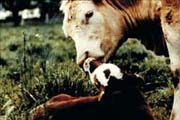 It is all very well to say that individuals must wrestle with their consciences—but only if their consciences are awake and informed. Industrial society, alas, hides animals’ suffering. Few people would themselves keep a hen in a shoebox for her egg-laying life; but practically everyone will eat smartly packaged, “farm fresh” eggs from battery hens…milk drinkers do not see the calves torn from their mothers.
It is all very well to say that individuals must wrestle with their consciences—but only if their consciences are awake and informed. Industrial society, alas, hides animals’ suffering. Few people would themselves keep a hen in a shoebox for her egg-laying life; but practically everyone will eat smartly packaged, “farm fresh” eggs from battery hens…milk drinkers do not see the calves torn from their mothers.
Chickens Raised for Meat
In the United States, virtually all birds raised for food are factory farmed.4 Inside the densely populated sheds, vast amounts of waste accumulate. The resulting ammonia levels commonly cause painful burns to the birds’ skin, eyes, and respiratory tracts.5

Today’s broiler reaches market weight in about one third the time it took the traditional broiler.2 This rapid growth rate has been accompanied by an increasingly high incidence of conditions that cause suffering, such as ascites and painful skeletal deformities.8 According to Professor John Webster of the University of Bristol’s School of Veterinary Science, “Broilers are the only livestock that are in chronic pain for the last 20% of their lives.”17 In order to avoid problems of reproduction and lameness associated with obesity, broilers used for breeding are severely feed restricted.5,8
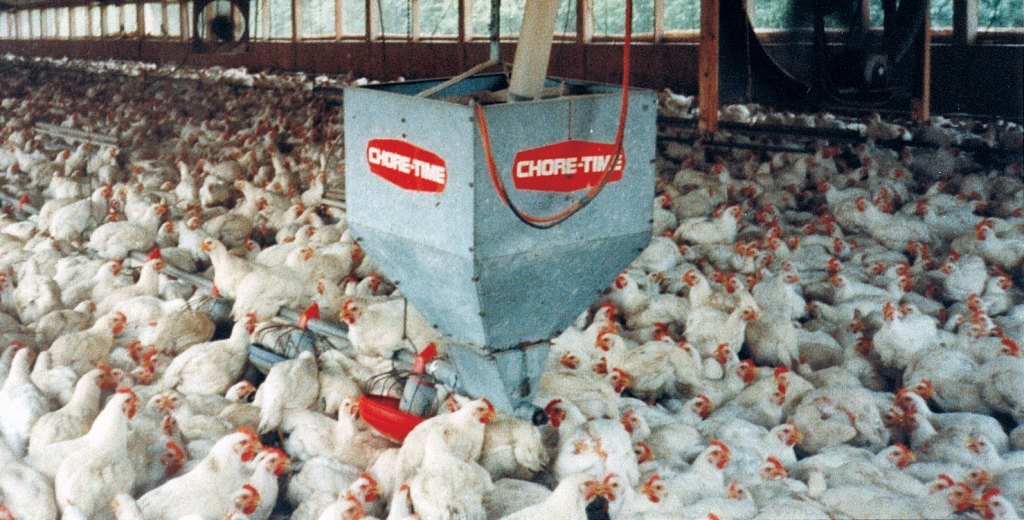
Egg-Laying Hens
Packed in cages (usually less than half a square foot of floor space per bird),6 hens can become immobilized and die of asphyxiation or dehydration. Decomposing corpses are found in cages with live birds.
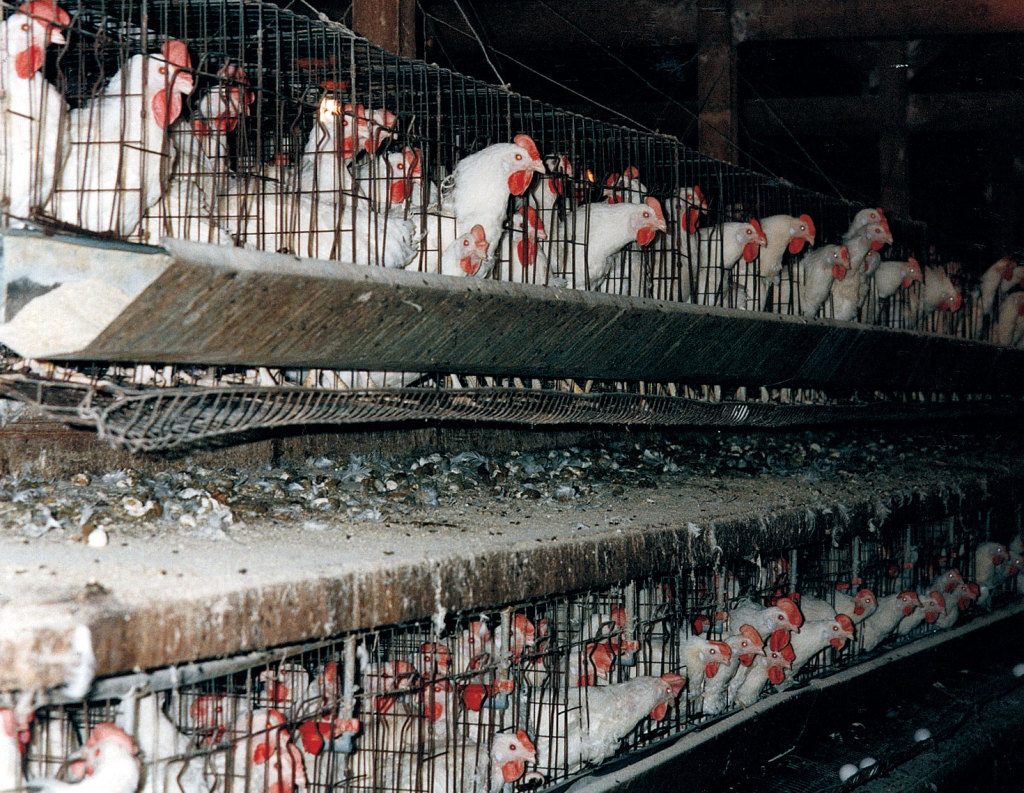
To cut losses from birds pecking each other, farmers remove a third to a half of the beak from egg-laying hens, breeding chickens, and most turkeys and ducks.27 Without pain relief, the beak is partially amputated with a heated blade; or the end is damaged with a laser, infrared beam, or powerful electric spark and sloughs off days later.8 The birds suffer severe pain for weeks.8 Some, unable to eat afterwards, starve.2
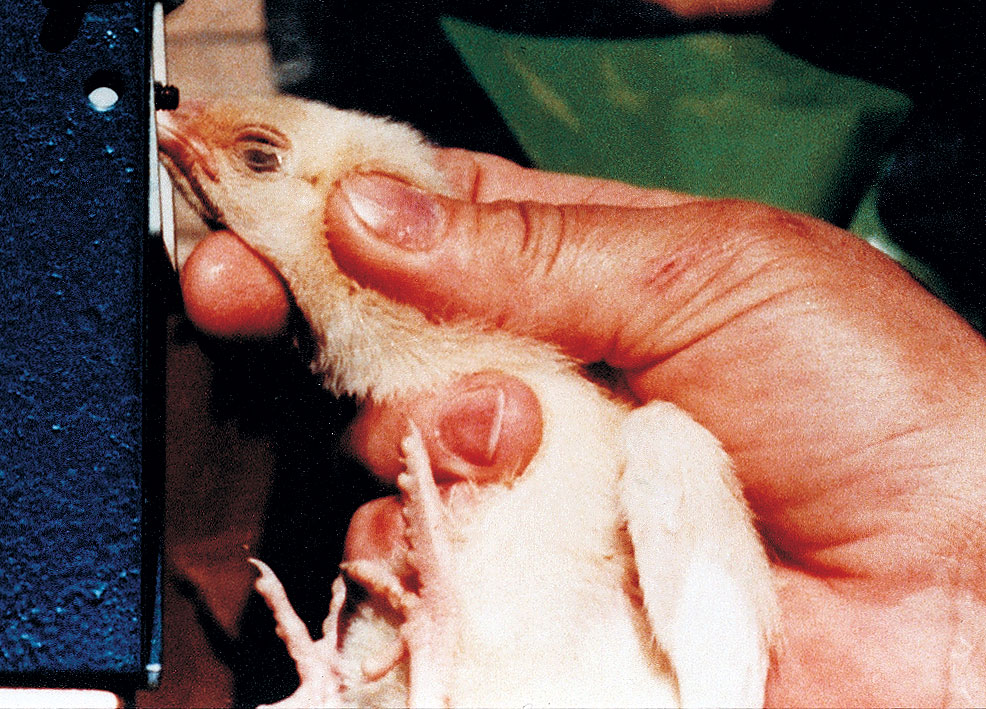
Each week, hundreds of thousands of laying hens die on U.S. farms.6,9 Most endure one to two years of battery-cage confinement before they’re disposed of as “spent hens.”6,8
By the time their egg production declines, the birds’ skeletons are so fragile that many suffer broken bones as they’re removed from the cages.8,36 Hens who are transported to slaughter often endure long journeys and sustain further injuries.8,36 Flocks killed on-site are gassed,6 rendered, composted, or destroyed by other means (for example, on two California farms, workers fed 30,000 live hens into wood chippers).
Male chicks, of no economic value to the egg industry, are typically macerated (ground up alive) or gassed.8 In some cases, they are simply thrown into garbage bags alive, as depicted in the picture below of chicks dead and dying in a dumpster behind a hatchery.
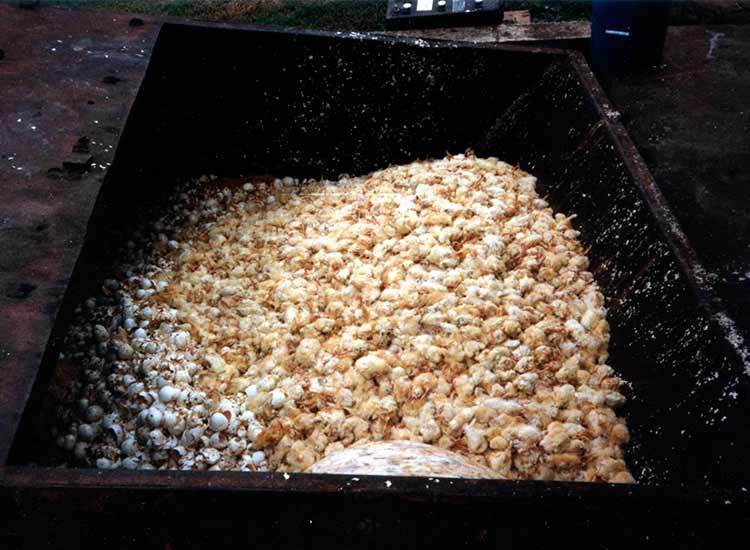
Our task must be to free ourselves from this prison by widening our circle of compassion to embrace all living creatures and the whole of nature in its beauty.
Pigs
In the September 1976 issue of the trade journal Hog Farm Management, John Byrnes suggested, “Forget the pig is an animal. Treat him just like a machine in a factory.”
Over 30 years later, National Pork Producers Council spokesperson Dave Warner showed dismay at the idea that pigs should be given more space:
So our animals can’t turn around for the 2.5 years that they are in the stalls producing piglets. I don’t know who asked the sow if she wanted to turn around.47

There’s a schizoid quality to our relationship with animals, in which sentiment and brutality exist side by side. Half the dogs in America will receive Christmas presents this year, yet few of us pause to consider the miserable life of the pig—an animal easily as intelligent as a dog—that becomes the Christmas ham.
Morley Safer described on 60 Minutes:
This [movie Babe] is the way Americans want to think of pigs. Real-life “Babes” see no sun in their limited lives, with no hay to lie on, no mud to roll in. The sows live in tiny cages, so narrow they can’t even turn around. They live over metal grates, and their waste is pushed through slats beneath them and flushed into huge pits.

On September 17, 2008, the Associated Press reported on a cruelty investigation performed by PETA at a pig farm in Iowa. The report stated in part:
The video, shot by People for the Ethical Treatment of Animals, shows farm workers hitting sows with metal rods, slamming piglets on a concrete floor and bragging about jamming rods into sows’ hindquarters…
At one point in the video, workers are shown slamming piglets on the ground, a practice designed to instantly kill those baby pigs that aren’t healthy enough. But on the video, the piglets are not killed instantly, and in a bloodied pile, some piglets can be seen wiggling vainly. The video also shows piglets being castrated, and having their tails cut off, without anesthesia.
To visit a modern CAFO (Confined Animal Feeding Operation) is to enter a world that, for all its technological sophistication, is still designed according to Cartesian principles: animals are machines incapable of feeling pain. Since no thinking person can possibly believe this any more, industrial animal agriculture depends on a suspension of disbelief on the part of the people who operate it and a willingness to avert your eyes on the part of everyone else.…
More than any other institution, the American industrial animal farm offers a nightmarish glimpse of what capitalism can look like in the absence of moral or regulatory constraint. Here in these places life itself is redefined—as protein production—and with it suffering. That venerable word becomes “stress,” an economic problem in search of a cost-effective solution, like tail-docking or beak-clipping or, in the industry’s latest plan, by simply engineering the “stress gene” out of pigs and chickens. Our own worst nightmare such a place may well be; it is also real life for the billions of animals unlucky enough to have been born beneath these grim steel roofs, into the brief, pitiless life of a “production unit” in the days before the suffering gene was found.
Dairy Cows
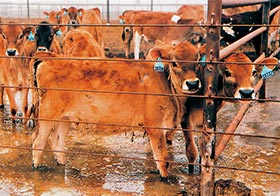
For many people, dairy farming conjures up images of small herds of cows leisurely grazing on open pastures. Although scenes like this still exist in the United States, most milk is produced by cows raised in intensive production systems.40 Some cows are housed indoors year-round,40 and lactating cows are often kept restrained in tie stalls or stanchions.43
From 1940 to 2016, average per-cow milk production rose from 2 to 11 tons per year;38 some cows have surpassed 36 tons.33 High milk yields often causes udder breakdown, leading to early slaughter.1
Although they don’t reach mature size until at least 4 years old, dairy cows first give birth at about 2 years of age and are usually bred again beginning at about 60 days after giving birth, to maintain a yearly schedule.40,43 It is unprofitable to keep dairy cows alive once their milk production declines. Each year, approximately one quarter of the cows who survive the farms are sent to slaughter,43 most often due to reproductive problems or mastitis.41 Cows can live more than 20 years, however they’re usually slaughtered and used to produce ground beef at about 5 years of age, after roughly 2.5 lactations.40
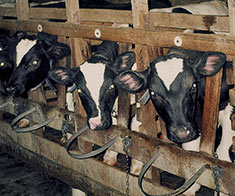
On the majority of dairy farms, calves are separated from their mothers within 12 hours of birth.43 The males are mainly sold for veal or castrated and raised for beef.40 “Bob veal” calves are killed as soon as a few days after birth; those used to produce “special-fed veal” are typically kept tethered in individual stalls until slaughtered at about 16 to 20 weeks of age.45 The female calves are commonly subjected to tail docking, dehorning, and the removal of “extra” teats.40,42 Most are kept in individual hutches or pens, often outdoors or in an unheated barn, and fed colostrum, then saleable or unsaleable/waste milk or a milk replacer until weaned, typically at about 9 weeks of age.43 Pneumonia and digestive disorders are the most common causes of death among female calves who survive beyond 48 hours but die before weaning.44
Historically, man has expanded the reach of his ethical calculations, as ignorance and want have receded, first beyond family and tribe, later beyond religion, race, and nation. To bring other species more fully into the range of these decisions may seem unthinkable to moderate opinion now. One day, decades or centuries hence, it may seem no more than “civilized” behavior requires.
The term “downer” refers to an animal who is too injured, weak, or sick to stand and walk. The exact number of downer cattle on U.S. farms or feedlots or sent to slaughter facilities is difficult to ascertain, but estimates approach 500,000 animals per year; most are dairy cows.46 Complications associated with calving and injuries from slipping and falling are leading causes.46
Evidence revealing widespread mistreatment of downer dairy cows hit the news in January 2008, when the Humane Society of the United States released footage from its undercover investigation of a California slaughter plant that supplied beef for the nation’s school lunch program:
In the video, workers are seen kicking cows, ramming them with the blades of a forklift, jabbing them in the eyes, applying painful electrical shocks and even torturing them with a hose and water in attempts to force sick or injured animals to walk to slaughter.…
Temple Grandin, a renowned expert on animal agriculture and professor at Colorado State University, called the images captured in the investigation “one of the worst animal abuse videos I have ever viewed.”
See the HSUS report and video, and this Washington Post article; also HSUS’s 2009 investigation of a dairy calf slaughter plant in Vermont.
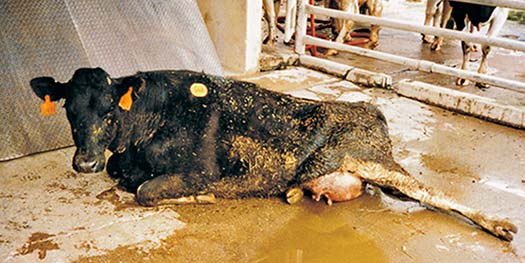
Transport and Stockyards
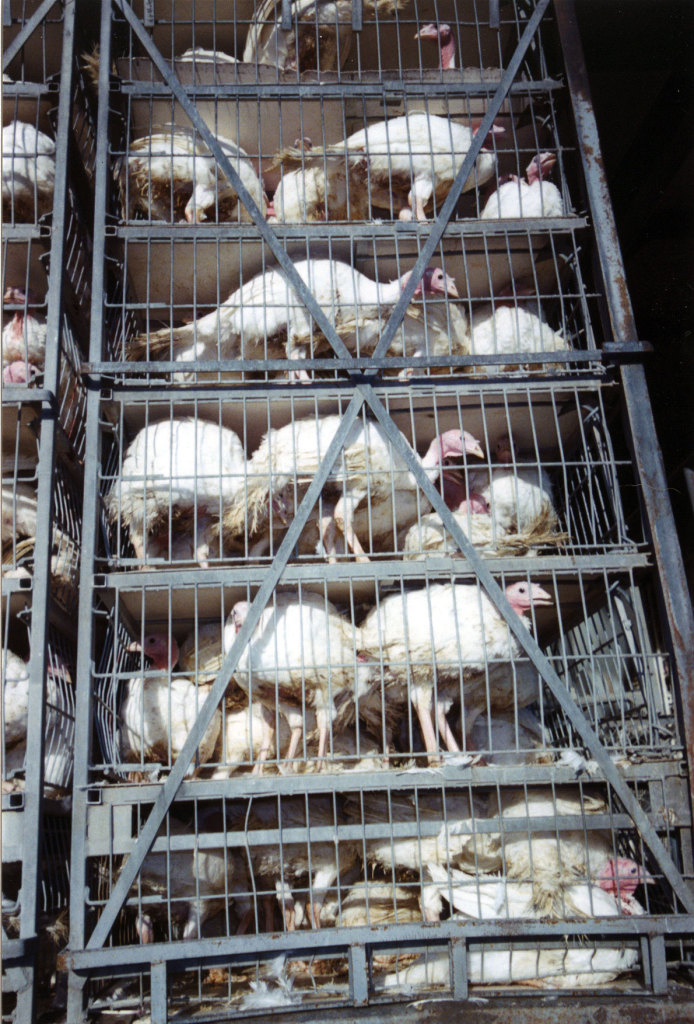
Before animals are slaughtered, they must be transported to the slaughterhouse. In the case of cows or steers, they are typically taken to a stockyard first, where they are auctioned off.
On the trucks, birds, pigs, sheep, or cows are crammed together. Mammals must stand in a slurry of urine, feces, and vomit; those who fall and can’t get up may be trampled or suffocate.16
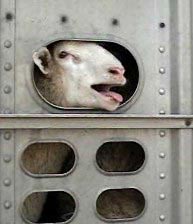
The slatted trucks expose the animals to extreme temperatures.2,10 Some may suffer dehydration or frostbite, or become frozen to the trailers or cages.10,16,34
Hot weather and humidity are deadly to pigs.10 Approximately 200,000 pigs die on their way to slaughter every year in the United States.35
Like this bull I had last year—this bull was one of the biggest bulls I’ve ever seen. It was at the very front of the trailer. And the spirit it had, he was just trying his hardest to get off the trailer. He had been prodded to death by three or four drivers…but his back legs, his hips have given out. And so basically they just keep prodding it. So it took about 45 minutes to get it from the front nose of the trailer to the back ramp.…
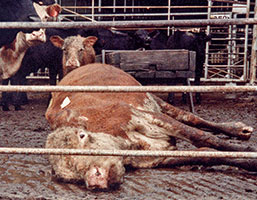
Then from there it was chained with its front legs, and it fell off the ramp, smashed onto the floor, which I don’t know how many feet that would be but quite a racket…I just said, “Why don’t you shoot the damn thing? What’s going on? What about this Code of Ethics?”
This one guy said, “I never shoot. Why would I shoot a cow that can come off and there’s still good meat there?” When I first started, I talked to another trucker about downers. He said, “You may as well not get upset. It’s been going on for many years. It will go on for the rest of my life and your life. So just calm down about it. It happens. You’ll get kind of bitter like I did. You just don’t think about the animals. You just think that they aren’t feeling or whatever.”
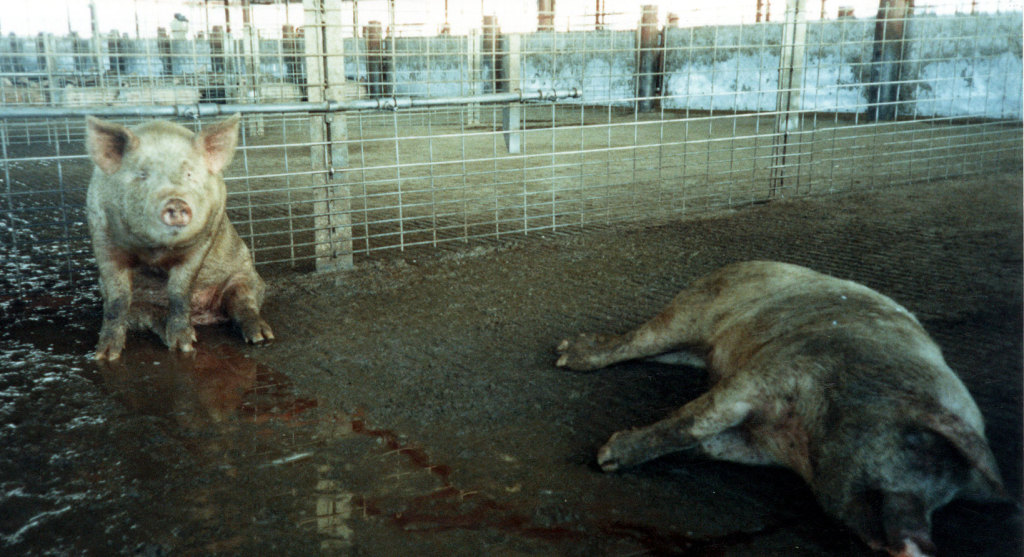
At Bushway, a calf slaughtering facility in Vermont, newborn male calves are typically brought in at one to seven days old. They are often trucked from long distances away, 10 or 12 hours or more, and they often arrive injured, weak and dehydrated. As a result, calves may arrive “downed” and unable to get up.…
I witnessed animal handlers at Bushway grab a downed calf by a hind leg and drag him down an unloading ramp. Another calf was dragged through the holding pens. Dragging any non-ambulatory animal is against regulations. During another delivery, a handler swore at a downed calf and threw him off the second tier of the hauling trailer like a football.…
Calves arriving at Bushway after slaughter hours were destined to spend yet another 12–18 hours without food, when already they had been deprived of sustenance for perhaps days, since they were usually removed from their mothers immediately after birth. Sometimes calves are held overnight and it always broke my heart that employees would carry the bodies of these dead baby calves out of the pen because they died of dehydration and starvation.
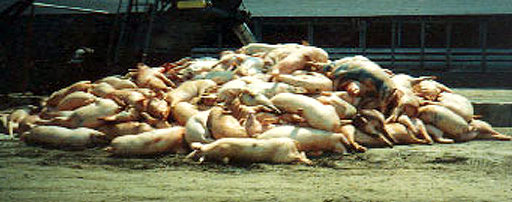
Slaughter
Animals who survive the farms and transport—whether factory-farmed or free-range—are slaughtered.
In the slaughterhouse, the animals can typically smell, hear, and often see the slaughter of those before them. As they struggle, they’re often abused by frustrated workers, who are under constant pressure to keep the lines moving at rapid speeds.
Mammal Slaughter
The Humane Methods of Slaughter Act, a federal law, requires mammals (other than rabbits) be stunned prior to slaughter (exempting religious slaughter). Typically, electric current is used to induce a heart attack and/or seizure; or a captive bolt gun is used to deliver a blow to the skull or shoot a rod into the animal’s brain.34
It’s not uncommon for an animal to suffer one or two failed stuns.25 In the case of a failed electrical stun, an animal may be paralyzed without losing sensibility.10 Unconscious animals whose necks are not cut soon enough may regain their senses after being hung on the bleed rail.34
The Washington Post reported that, “Hogs, unlike cattle, are dunked in tanks of hot water after they are stunned to soften the hides for skinning. As a result, a botched slaughter condemns some hogs to being scalded and drowned. Secret videotape from an Iowa pork plant shows hogs squealing and kicking as they are being lowered into the water.”20
You have just dined, and however scrupulously the slaughterhouse is concealed in the graceful distance of miles, there is complicity.
Religious Slaughter
During religious slaughter, such as kosher and halal, animals are usually fully conscious as their throats are cut.34 This is supposed to induce rapid loss of consciousness. However, in a study of cattle at five kosher slaughter plants in several different countries, the time—from the end of the cut until the eyes rolled back and the cow started to collapse—ranged from 8 to 120 seconds.18 Some cattle may have prolonged periods of sensibility lasting up to 385 seconds.19
Animals are God’s creatures, not human property, nor utilities, nor resources, nor commodities, but precious beings in God’s sight.
Undercover videos taken by PETA between 2004 and 2008 at two U.S. kosher slaughterhouses revealed workers ripping the tracheas and esophagi from the throats of fully conscious cattle after the ritual cut; some of the animals are shown writhing in pools of blood, struggling to stand for minutes afterwards.
In Thinking in Pictures, Dr. Temple Grandin describes the “shackle and hoist” method of ritual slaughter:
Prior to slaughter, live cattle were hung upside down by a chain attached to one back leg. It was so horrible I could not stand to watch it. The frantic bellows of terrified cattle could be heard in both the office and the parking lot. Sometimes an animal’s back leg was broken during hoisting.
The shackle and hoist procedure can be seen in PETA’s December 2009 video footage of a South American plant that supplies kosher meat to the United States.
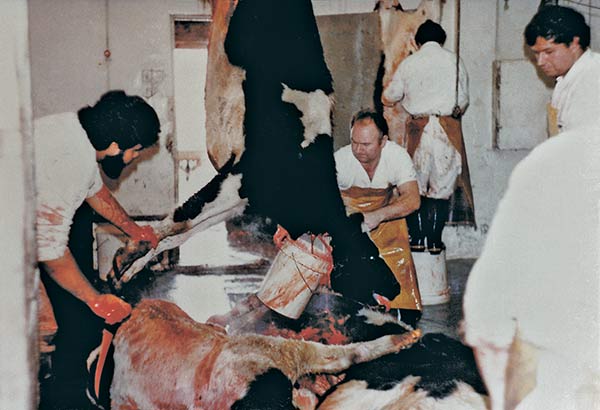
See also: If This Is Kosher… video; “shechita” photos.
Do we, as humans, having an ability to reason and to communicate abstract ideas verbally and in writing, and to form ethical and moral judgments using the accumulated knowledge of the ages, have the right to take the lives of other sentient organisms, particularly when we are not forced to do so by hunger or dietary need, but rather do so for the somewhat frivolous reason that we like the taste of meat?
In essence, should we know better?
Bird Slaughter
Over 95 percent of U.S. land animals killed for food are birds, yet they are exempt from the federal Humane Methods of Slaughter Act and there is no federal law requiring they be handled humanely.34 To facilitate automated slaughter, birds are usually immobilized via electrical stunning. Hanging in shackles, the birds’ heads are passed through an electrified water bath.8
It is not known whether this renders them unconscious,2 and the potential for birds suffering severely painful pre-stun shocks is difficult to eliminate.21 Each year, several hundred thousand chickens and turkeys reach the scalding tanks alive.7,22,24
In 2015, the Humane Society of the United States released a video documenting the scalding of live hens, forced upside down into tanks of scorching hot water in which they drown. Watch the video below.
Turkeys enter the slaughter area, hanging shackled by their legs. The pain birds suffer from shackling can be extreme and inevitably causes violent wing flapping, which may result in dislocated joints and broken bones.21 Due to their wingspan, turkeys are prone to intensely painful pre-stun shocks.21
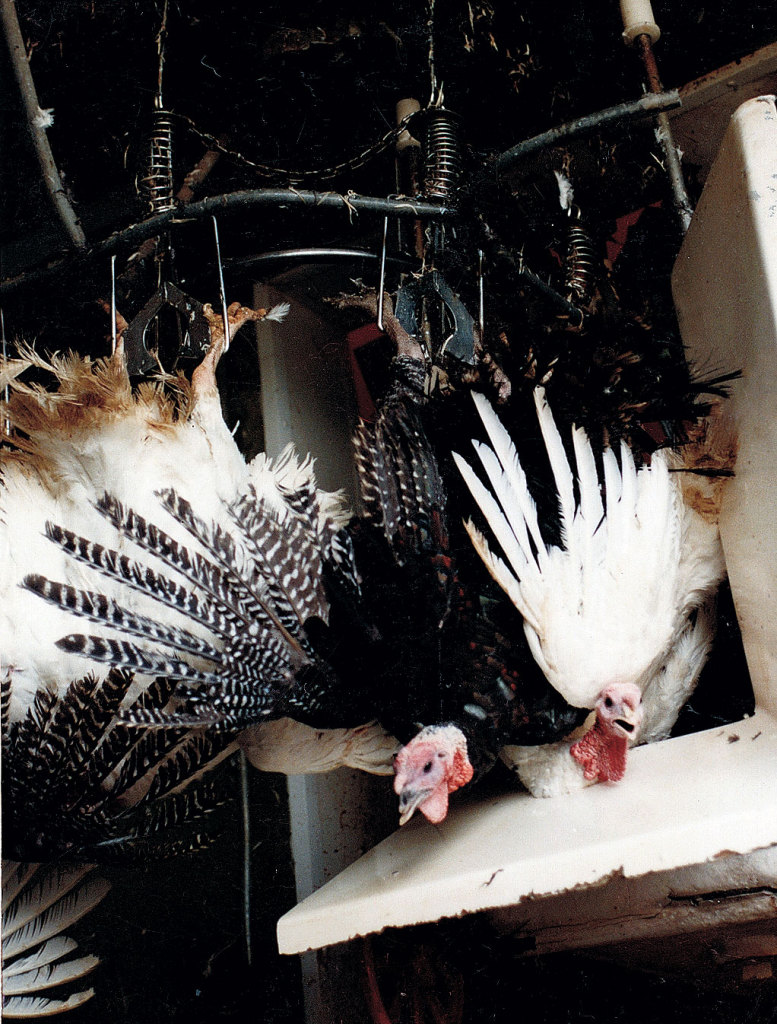
In January of 2007, a Mercy For Animals investigator took a job in North Carolina at one of the nation’s largest poultry slaughterhouses to witness the conditions firsthand: Birds with broken legs and wings, open wounds, and large tumors were shackled and hung on the slaughter line; some of the injured were left writhing on the floor for hours beforehand. Workers punched, kicked, threw, and mutilated live birds; they tore eggs from the birds’ cloacae to toss at coworkers, and ripped the heads off birds who were trapped inside the transport cages.
A year later, PETA released footage of two other large plants, in Tennessee and Georgia, where many conscious birds were mangled by the killing machines or had their heads yanked off by workers. PETA’s 2005 investigation of an Alabama plant, also found the neck-cutting machines routinely missed, slicing open the chickens’ wings, faces, and other body parts; numerous birds entered the scalding tanks for feather removal while fully conscious. The three facilities were owned by Tyson, a leading supplier to KFC.
Between October 2003 and May 2004, an undercover PETA investigator captured footage at a Pilgrim’s Pride chicken slaughterhouse in West Virginia. Workers were filmed violently and repeatedly throwing live chickens into a wall, picking chickens up by their legs and swinging their heads into the floor, and kicking and jumping up and down on live chickens. According to a New York Times article on the investigation, this plant had previously received KFC’s “Supplier of the Year” award.
Below are two of the many chickens whose bodies were sliced open by the killing machines at the Alabama plant investigated by PETA in 2005.
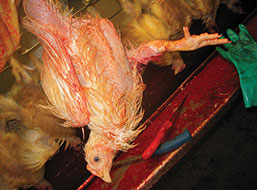 |
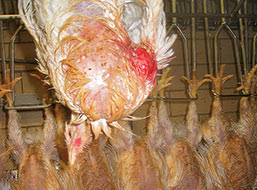 |
Legal Oversight
On March 4, 2010, the House Oversight and Government Reform Committee held a hearing on the Continuing Problems in the USDA’s Enforcement of the Humane Methods of Slaughter Act. Stan Painter, who served as a Food Safety and Inspection Service (FSIS) inspector for more than 24 years and has been chairman of the National Joint Council of Food Inspection Local Unions for over 6 years, testified:
The agency claimed that there was a full complement of staffing at Hallmark/Westland when that situation came to light, yet the facility management was able to game the system and abused animals in order to squeeze every last penny for the bottom line. There are some slaughter facilities in this country that are processing cattle at 390 head per hour and hogs at 1106 head per hour. At that rate of production, we would need to increase the number of inspectors assigned to be able to enforce all of laws and regulations adequately…
We are also hamstrung by our supervisors who are either not qualified to do their jobs, unwilling to let us do our jobs, or who are not committed to making animal welfare a priority—either in FSIS-regulated facilities or in their private lives.
True human goodness, in all its purity and freedom, can come to the fore only when its recipient has no power.
Humanity’s true moral test, its fundamental test (which lies deeply buried from view), consists of its attitude towards those who are at its mercy: animals.
And in this respect humankind has suffered a fundamental debacle, a debacle so fundamental that all others stem from it.
Dr. Dean Wyatt, an FSIS supervisory public health veterinarian for over 18 years, provided a statement citing several examples of the violations he observed—at both Bushway and Seaboard Farms, a large pig slaughterhouse in Oklahoma—and the struggles he endured trying to enforce the law:
When upper-level FSIS management looks the other way as food safety or humane slaughter laws are broken, or, as has been my experience, retaliates against people who are enforcing those laws, then management is just as guilty for breaking those laws as are the establishments. The laws are there. The enforcement of those laws—in my experience—has not been there and, in fact, has been willfully ignored by well-paid public officials.…
It seems almost unbelievable to me, but I have been ignored by my own people and have suffered physically, emotionally, and financially in the process. More importantly, animal welfare and food safety have suffered as well.
Humans—who enslave, castrate, experiment on, and fillet other animals—have had an understandable penchant for pretending animals do not feel pain. A sharp distinction between humans and “animals” is essential if we are to bend them to our will, make them work for us, wear them, eat them—without any disquieting tinges of guilt or regret.
It is unseemly of us, who often behave so unfeelingly toward other animals, to contend that only humans can suffer. The behavior of other animals renders such pretensions specious. They are just too much like us.
Fish
An article published in the Journal of Fish Biology explains:
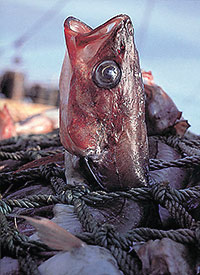
The scientific study of fish welfare is at an early stage compared with work on other vertebrates and a great deal of what we need to know is yet to be discovered. It is clearly the case that fish, though different from birds and mammals, however, are sophisticated animals, far removed from unfeeling creatures with a 15 second memory of popular misconception.…
[I]t has been argued that the longer the life span of a given species of animal and the more sophisticated its general behaviour, the greater its need for complex mental processes similar to those that in humans generate the conscious experience of suffering. In this context, therefore, it is relevant that the longest-living vertebrates are found among the fishes and that fish behaviour is rich, complicated and far from stereotyped.… Indeed, current literature on fish cognition indicates that several fish species are capable of learning and integrating multiple pieces of information that require more complex processes than associative learning.12
The fastest growing food-producing sector is aquaculture; one of two fish eaten is now raised on a farm rather than caught in the wild.39 As with other forms of animal agriculture, the practices employed by fish farmers are designed to increase profitability but can reduce the well-being of the fish. Welfare concerns include: poor water quality, aggression, injuries, and disease associated with inappropriate stocking densities; health problems due to selection for fast growth; handling and removal from water during routine husbandry procedures; food deprivation during disease treatment and before harvest; and pain during slaughter.12,32
There is evidence from some species of fish, cephalopods and decapod crustaceans of substantial perceptual ability, pain and adrenal systems, emotional responses, long- and short-term memory, complex cognition, individual differences, deception, tool use, and social learning.
In the world’s marine fisheries, 87 percent of fish stocks are already fully exploited, overexploited, or depleted.13 A UN Chronicle article on overfishing warns that “oceans are cleared at twice the rate of forests” and “the dramatic increase of destructive fishing techniques destroys marine mammals and entire ecosystems.”14 It’s estimated that, each year, hundreds of thousands of dolphins, seals, and other marine mammals die in fishing nets worldwide.23
What You Can Do
It is easy for us to criticize the prejudices of our grandfathers, from which our fathers freed themselves.
It is more difficult to distance ourselves from our own views, so that we can dispassionately search for prejudices among the beliefs and values we hold.
The good news is that you can choose to remove your support from these abusive practices by adding delicious vegan foods to your meals! Please check out our online guide to eating vegan here. Thank you for caring about these animals.
References
1. Robert W. Taylor and Tom G. Field, textbook Scientific Farm Animal Production, 8th ed. (Prentice Hall, 2004).
2. Bernard E. Rollin, PhD, Farm Animal Welfare (Iowa State University Press, 2003).
3. National Hog Farmer, 15 November 1993.
4. Peter Cheeke, PhD, textbook Contemporary Issues in Animal Agriculture, 2004.
5. Inma Estevez, “Ammonia and Poultry Welfare,” Poultry Perspectives (MD Cooperative Extension), 2002; 4(1).
6. United Egg Producers, Animal Husbandry Guidelines for U.S. Egg Laying Flocks 2016 Edition.
7. USDA NASS, Poultry Slaughter 2015 Summary, February 2016.
8. G. John Benson, DVM, MS, and Bernard E. Rollin, PhD, eds., The Well-Being of Farm Animals: Challenges and Solutions (Blackwell Publishing, 2004).
9. Joy A. Mench, PhD, in “Scientist Discusses Hen Housing” by Rod Smith, Feedstuffs FoodLink, 28 September 2007.
10. Temple Grandin, PhD, Recommended Animal Handling Guidelines & Audit Guide July 2013 Edition, Rev. 1 (American Meat Institute Foundation).
12. “Current issues in fish welfare,” J Fish Biol, 2006; 68: 332–72.
13. Food and Agriculture Organization of the United Nations, The State of World Fisheries and Aquaculture 2012 (Rome, 2012).
14. Udy Bell, “Overfishing,” UN Chronicle, 2004; 41(2): 17.
16. “Conditions of transfer and quality of food,” Rev Sci Tech Off Int Epiz, 2006; 25(2): 675–84.
17. Professor John Webster quoted in The Guardian, 14 October 1991.
18. Temple Grandin, PhD, “Kosher Box Operation, Design, and Cutting Technique will Affect the Time Required for Cattle to Lose Consciousness,” updated April 2014; accessed 8 August 2016.
19. Temple Grandin, PhD, “ Welfare During Slaughter without stunning (Kosher or Halal) differences between Sheep and Cattle,” updated September 2012; accessed 25 March 2014.
20. Joby Warrick, “Modern Meat: A Brutal Harvest, ‘They Die Piece by Piece,’” Washington Post, 10 April 2001.
21. European Food Safety Authority, Scientific Report AHAW/04-027, 15 June 2004.
22. USDA FSIS, Poultry Slaughter Inspection Training, “Poultry Postmortem Inspection,” 16 December 2014.
23. Andrew J. Read et al., “Bycatch of Marine Mammals in U.S. and Global Fisheries,” Conserv Biol, 2006 Feb; 20(1): 163–69.
24. R.J. Buhr, “Why poultry should be stunned at slaughter and the welfare advantages and challenges of electrical and gas stunning,” 2009; in Proceedings XIX European Poultry Symposium on Quality of Poultry Meat and XIII European Symposium on the Quality of Eggs and Egg Products, 21–25 June 2009 (Turku, Finland: World’s Poultry Science Association).
25. U.S. GAO, “Humane Methods of Slaughter Act: Actions Are Needed to Strengthen Enforcement,” Report to Congressional Requesters GAO-10-203, February 2010.
27. USDA ARS, “Settling Doubts About Livestock Stress,” Agricultural Research, 2005 Mar; 53(3): 4–7.
32. Paul J. Ashley, “Fish welfare: Current issues in aquaculture,” Appl Anim Behav Sci, 2007 May; 104(3): 199–235.
33. Jim Dickrell, “New National Milk Production Record Set,” Dairy Herd Management, 27 January 2017.
34. USDA FSIS, PHV Intern, “Disposition/Food Safety: Humane Handling of Livestock/GCP in Poultry,” January 2015.
35. M. J. Ritter et al., “Review: Transport Losses in Market Weight Pigs: A Review of Definitions, Incidence, and Economic Impact,” Prof Anim Sci, 2009 Aug; 25(4): 404–14.
36. A. B. Webster, “Welfare Implications of Avian Osteoporosis,” Poult Sci, 2004; 83: 184–92.
38. USDA NASS, Quick Stats, https://quickstats.nass.usda.gov; accessed 24 March 2017.
39. FAO Aquaculture Newsletter, No. 45, August 2010.
40. U.S. EPA, Ag 101: Dairy Production, 27 June 2012; accessed 27 May 2013.
41. USDA APHIS VS NAHMS, Dairy 2007, Part I: Reference of Dairy Cattle Health and Management Practices in the United States, October 2007.
42. USDA APHIS VS NAHMS, Dairy 2007: Heifer Calf Health and Management Practices on U.S. Dairy Operations, January 2010.
43. USDA APHIS VS NAHMS, Dairy 2014: Dairy Cattle Management Practices in the United States, February 2016.
44. USDA APHIS VS NAHMS, Dairy Heifer Raiser 2011: An overview of operations that specialize in raising dairy heifers, October 2012.
45. American Veterinary Medical Association, Welfare Implications of the Veal Calf Husbandry, 13 October 2008.
46. JAVMA, 2007; 231(2): 227–34.
47. Ben Terris, “Animal-Rights Issue Complicates Farm Bill,” National Journal, 24 July 2012.